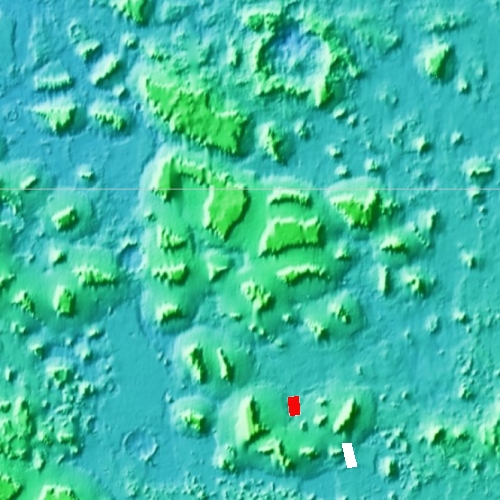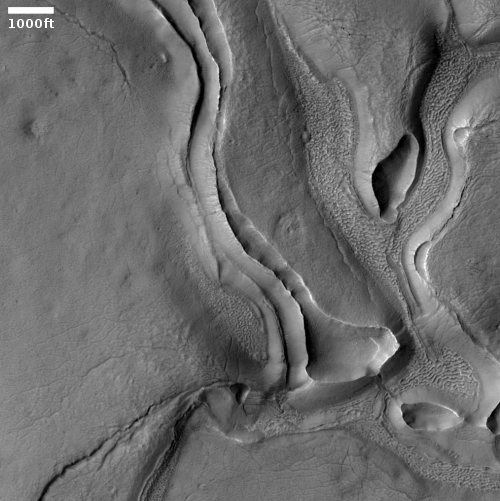Glacial ice sheets on Mars?
Cool image time! The photo to the right, rotated, cropped, and reduced to post here, was taken on June 29, 2021 by the high resolution camera on Mars Reconnaissance Orbiter (MRO). The location is in Mars’ glacier country, that strip of chaos terrain that runs about 2,000 miles along the transition zone between the northern lowland plains and the southern cratered highlands at 30 to 47 degrees north latitude. This particular feature is located in Deuteronilus Mensae, the westernmost region of that strip of chaos.
I call this glacier country because practically every image taken by MRO’s high resolution camera in this region suggests the presence of glacial material covered by a protective layer of debris. The photo to the right is typical, though a bit more puzzling because of the depressions that appear to run along highpoints.
As usual, the overview map below helps explain what we are looking at.

The red rectangle marks the location of the above image. The white rectangle marks the location of an earlier cool image from May 2020.
As you can see, both images cover the edge of a large apron of material that is descending down from a collection of high buttes. Though the overview map suggests the downhill grade should be to the north, in the picture itself it appears the flows are heading south, both in that ridgeline depression as well as in the meandering hollows to its east.
The ridgeline depression suggests that a glacier flowed south into the largest wide depression, with some of that flow breaking out through a gap on its southern wall.
Overall, the inconclusive downhill grade suggests that we are actually looking at broken ice sheets, protected from sublimation by a thin layer of dust and debris. This supposition becomes even more obvious in the full image. Apparently, the apron of glacial material and alluvial debris that surrounds the buttes are in turn surrounded in the flats by cracking ice sheets.
While this region will afford settlers ample and easily accessible water, the roughness of the terrain will likely not make it an initial prime target for colonization. Too difficult for landing, and too difficult to travel through.
Someday, however, when many humans live on Mars, this land will be an inviting target. Not only will it provide that water, the buttes will likely make other resources readily available for mining.
The map below shows this entire 2,000-mile-long strip of glacier-filled chaos, with the red dot marking the location of today’s image.

On Christmas Eve 1968 three Americans became the first humans to visit another world. What they did to celebrate was unexpected and profound, and will be remembered throughout all human history. Genesis: the Story of Apollo 8, Robert Zimmerman's classic history of humanity's first journey to another world, tells that story, and it is now available as both an ebook and an audiobook, both with a foreword by Valerie Anders and a new introduction by Robert Zimmerman.
The print edition can be purchased at Amazon or from any other book seller. If you want an autographed copy the price is $60 for the hardback and $45 for the paperback, plus $8 shipping for each. Go here for purchasing details. The ebook is available everywhere for $5.99 (before discount) at amazon, or direct from my ebook publisher, ebookit. If you buy it from ebookit you don't support the big tech companies and the author gets a bigger cut much sooner.
The audiobook is also available at all these vendors, and is also free with a 30-day trial membership to Audible.
"Not simply about one mission, [Genesis] is also the history of America's quest for the moon... Zimmerman has done a masterful job of tying disparate events together into a solid account of one of America's greatest human triumphs."--San Antonio Express-News
Cool image time! The photo to the right, rotated, cropped, and reduced to post here, was taken on June 29, 2021 by the high resolution camera on Mars Reconnaissance Orbiter (MRO). The location is in Mars’ glacier country, that strip of chaos terrain that runs about 2,000 miles along the transition zone between the northern lowland plains and the southern cratered highlands at 30 to 47 degrees north latitude. This particular feature is located in Deuteronilus Mensae, the westernmost region of that strip of chaos.
I call this glacier country because practically every image taken by MRO’s high resolution camera in this region suggests the presence of glacial material covered by a protective layer of debris. The photo to the right is typical, though a bit more puzzling because of the depressions that appear to run along highpoints.
As usual, the overview map below helps explain what we are looking at.

The red rectangle marks the location of the above image. The white rectangle marks the location of an earlier cool image from May 2020.
As you can see, both images cover the edge of a large apron of material that is descending down from a collection of high buttes. Though the overview map suggests the downhill grade should be to the north, in the picture itself it appears the flows are heading south, both in that ridgeline depression as well as in the meandering hollows to its east.
The ridgeline depression suggests that a glacier flowed south into the largest wide depression, with some of that flow breaking out through a gap on its southern wall.
Overall, the inconclusive downhill grade suggests that we are actually looking at broken ice sheets, protected from sublimation by a thin layer of dust and debris. This supposition becomes even more obvious in the full image. Apparently, the apron of glacial material and alluvial debris that surrounds the buttes are in turn surrounded in the flats by cracking ice sheets.
While this region will afford settlers ample and easily accessible water, the roughness of the terrain will likely not make it an initial prime target for colonization. Too difficult for landing, and too difficult to travel through.
Someday, however, when many humans live on Mars, this land will be an inviting target. Not only will it provide that water, the buttes will likely make other resources readily available for mining.
The map below shows this entire 2,000-mile-long strip of glacier-filled chaos, with the red dot marking the location of today’s image.

On Christmas Eve 1968 three Americans became the first humans to visit another world. What they did to celebrate was unexpected and profound, and will be remembered throughout all human history. Genesis: the Story of Apollo 8, Robert Zimmerman's classic history of humanity's first journey to another world, tells that story, and it is now available as both an ebook and an audiobook, both with a foreword by Valerie Anders and a new introduction by Robert Zimmerman.
The print edition can be purchased at Amazon or from any other book seller. If you want an autographed copy the price is $60 for the hardback and $45 for the paperback, plus $8 shipping for each. Go here for purchasing details. The ebook is available everywhere for $5.99 (before discount) at amazon, or direct from my ebook publisher, ebookit. If you buy it from ebookit you don't support the big tech companies and the author gets a bigger cut much sooner.
The audiobook is also available at all these vendors, and is also free with a 30-day trial membership to Audible.
"Not simply about one mission, [Genesis] is also the history of America's quest for the moon... Zimmerman has done a masterful job of tying disparate events together into a solid account of one of America's greatest human triumphs."--San Antonio Express-News



Bob,
That photo almost looks like a ESM of something organic. Mars is so weird. Keep them coming and I’ll keep marveling at how something so close can be so different.
Thanks again